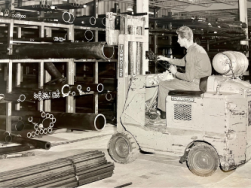State of Steel - November 2022
Pricing - Steel Index Continues to Drop
Steel pricing continues to be conflicting depending on what type and shape it is. Structural tubing prices continue to decline amid weaker demand and oversupply in the marketplace. Pricing is on the decline still due to the CRU index continuing to freefall.
While structural tube pricing declines, mechanical tubing pricing remains elevated and lead times continue to be very long. Most DOM and CDS prices seem to be hovering at their peak with no sign of decline coming. Contract pricing has seen several increases due to continued inflationary pressures and the necessity to assure the sustainability of the individual mills.
CRU came in at $669/ton this week. Last week it was $687/ton. Week-over-week change is -$18/ton. Looks like HRC is back on a downward trend with back-to-back week losses. The below charts reflect the CRU index and a current listing of all price increases/decreases on tubing that we have seen within the last year or so.



Cast Iron Pricing
November did not see any base increases for cast iron. Since January of 2021, Dura-Bar has increased their base prices a total of 4 times. Surcharges appear to have topped out in May as we have now seen surcharge decreases six months in a row. The below chart details the Dura-Bar surcharges over the last year or so.

Scrap & Steel Inputs
Ahead of the November scrap buy week, market sources indicated the demand for scrap appears to be worsening more than expected, despite logistical disruptions from the low Mississippi River water levels. Sources cite weak export demand (no ferrous export sales have been reported since 10/27) and weak domestic demand. Market expectations range from ‘soft-sideways’ to a $30/ton month-over-month decline for all grades. If scrap prices do decline in November this would mark the 7th consecutive monthly decline, bringing scrap prices to their lowest levels since November 2020. (Source: Platts)
Metal Production
In the week ended October 29, US raw steel production decreased 0.4% week-over-week to 1,663,000 tons (-9.4% YoY). US capacity utilization was 74.5% vs 83.2% last year. This marks 17 consecutive weeks where capacity utilization has been below 80%. Weekly production hit its lowest level since January 2021 and weekly utilization rates hit their lowest levels since December 2020. Year-to-date production is 74,707,000 tons down 4.7% year-over-year from 78,392,000 last year. (Source: AISI)
Lead Times
Understanding lead times for steel products are important to every participant in the supply chain. Lead times for steel products are as follows (as of 11/10/22):
Average HRC lead times decreased last week to 4.7 weeks, which is below the average of 5.6 weeks since 2016. Other product lead times were flat to higher last week with CRC lead times at 6.3 weeks, HDG lead times at 6.7 weeks, and plate lead times at 5.6 weeks. (Source: Platts)
DOM, HRS and CDS Tubing lead times continue to be long but have shortened slightly and are now anywhere from 24 to 36 weeks. The long lead times are due to backlog, supply issues, contract business and labor shortages. We continue to see lead times be long and are now seeing availability not free up until mid-2023.
Structural Tubing mill lead times are shortened and running approximately 2-3 weeks upon receipt of order. Common sizes we can get sooner for now.
Dura-Bar Continuous Cast Iron mill lead times are approximately 5-7 weeks depending on size, grade, and finish. If it’s a large bar, special grade, size, or shape then the lead time could be considerably longer.
Imports/Exports
In October, the largest steel import permit applications were for Canada (554,000 NT, up 3% from the September final), Mexico (420,000 NT, up 33%), Brazil (199,000 NT, up 5%), South Korea (117,000 NT, down 62%) and Germany (109,000 NT, up 41%). Through the first ten months of 2022, the largest suppliers were Canada (5,804,000 NT, down 1%), Mexico (4,635,000 NT, up 24%), and South Korea (2,359,000 NT, up 3%). (Source: AISI)
Economic Factors
Nonfarm payrolls grew by 261 thousand in October, better than the estimate of 205 thousand. The unemployment rate increased to 3.7%, which was worse than the estimate of 3.5%. Average hourly earnings increased 4.7% year-over-year, which is below the inflation rate. The number of job openings in the US increased to 10.72 million in September, a 7% increase from the 10.05 million reported in August, and above analyst estimates of 9.85 million openings (also well above the 2019 pre-pandemic average of 7.2 million openings). This followed the significant and unexpected decline in August. (Source: CNBC)
The Federal Reserve lifted interest rates by 0.75% and signaled plans to keep raising them, though possibly in smaller increments. (Source: Wall Street Journal)
Sales of newly constructed single-family homes declined 10.9% month-over-month in September and declined by 17.6% year-over-year. (Source: SMU)
US manufacturing activity grew at its slowest pace in nearly two-and-a-half years in October, according to the Institute for Supply Management (ISM). October’s Manufacturing PMI fell to 50.2%, down from 50.9% in September and the lowest reading since May 2020. Despite the month-over-month decline, October’s result marked the 29th consecutive month of expansion (index reading above 50%). (Source: SMU)
Oil & Gas Industry
The US rig count decreased 0.4% week-over-week to 768 rigs as of 10/28. The rig count is up 41.2% year-over-year. (Source: Baker Hughes)
OPEC+ producers agreed Oct. 5, 2022, to reduce crude oil production targets by 2 million barrels per day from previously stated targets beginning in November 2022. The US Energy Information Administration (EIA) expects that Saudi Arabia, Kuwait, and the United Arab Emirates (UAE) will account for most of OPEC’s share of the cut, the agency said in its latest Short-Term Energy Outlook (STEO), noting its production forecast for other OPEC members remains largely unchanged from its assessment made before the Oct. 5 announcement. Total OPEC crude oil production in EIA’s forecast falls to 28.6 million barrels per day in fourth-quarter 2022 from an average 29.2 million barrels per day in this year’s third quarter, largely unchanged from last month’s STEO forecast. OPEC crude oil production in the forecast averages 28.9 million barrels daily in 2023. (Source: Oil & Gas Journal)
Steel Supply
Highbar, a newly formed company founded by Dave Stickler (former CEO of Big River Steel), announced plans to build a $500 million greenfield rebar mini mill in Northeast Arkansas. The mill will have annual capacity of 600 thousand tons. Highbar expects to break ground in 2Q2023 with construction expected to take 22 months (implying an early 2025 start-up). Highbar expects this EAF to be the first of two rebar mills. (Source: Platts)






